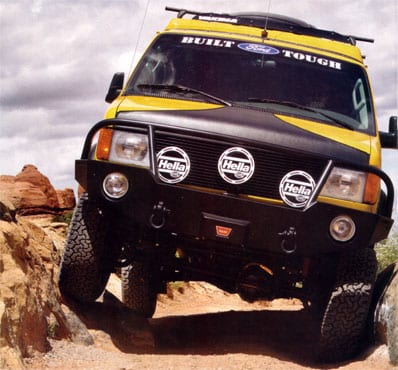


A Rolling Base Camp for Outdoor Enthusiasts, Going Where No Motorhome Dares
Story and photography by Alan Rider

For those interested in loading up an assortment of outdoor toys and heading for the blank spaces on the map, it may be time to consider a Sportsmobile. Providing an alternative to tent camping has developed into something of a specialty for Alan Feld and his crew at the Fresno, California-based Sportsmobile West. The group has been turning ordinary cargo vans into campers for four decades, offering Quigley four-wheel-drive systems underneath them since 1989. The result is a compact expedition-quality camper that achieves a combination of around-town maneuverability, open-road fuel-economy, serious off-road capability, and back country camping practicality matched by few other vehicles.
The Ultimate Project
As with all good extreme makeovers, the first step in our Ultimate Adventure Vehicle project was to tear apart a perfectly good vehicle, in this case a stock one-ton Ford Econoline E-350 cargo van. While the company will do conversions on GM vans, Sportsmobile only installs its four-wheel-drive system on Blue Oval platforms.
Underneath the hood, the Ultimate Adventure Vehicle uses Ford’s 6.0-liter diesel engine. The motor’s 235 horsepower and 440 pound-feet of torque provide ample grunt for off-road exploring and hauling trailers up to 10,000 pounds, while returning what canonly be described as outstanding fuel economy — by full-size SUV or motorhome standards — of about 18 mpg. A 46-gallon replacement tank gives the van an 800-plus-mile range between fill-ups.
From the five-speed automatic transmission, power goes to an Atlas II all-rear-driven transfer case from Advance Adapters. The twin-lever design allows front and rear differentials to be engaged independently, giving the vehicle tremendous versatility. For example, a broken rear driveshaft, which might stop another vehicle in its tracks, is a temporary obstacle in this van — once the rear end is put in neutral, the Sportsmobile can front-drive its way out of the boonies under its own power.
As a finishing touch, the Ultimate Adventure Vehicle sports a set of 16×8.0-inch simulated headlock wheels from U.S. Wheel. To balance on- and off-road performance, a set of 285/75R16 Bridgestone Dueler A/T Revo all-terrains were mounted.
Inside, we chose Sportsmobile’s most popular floorplan, the RB-50, because of its abundant storage space and open layout, incorporating the company’s 3.5×8.0-foot popup/fold-down roof provided a more aerodynamic profile for improved fuel economy when driving on the highway and a lower center of gravity off-road. When it’s time to make camp for the night, the top’s built-in electric motors raise the roof at the touch of a button to provide a full 6.75 feet of stand-up height. With a roomy upper bed and fold-out sofa, it can easily sleep four adults.
All the comforts of home are here, too, including a two-burner propane stove, microwave, 2.7-cubic-foot refrigerator, kitchen sink, electric-flush porta-potty, propane furnace and water heater, 10-gallon fresh-water tank, and 115-volt AC power. After a long day on the dusty trails, swing open the rear doors and attach bow-shaped rod with privacy curtain, and you can enjoy a hot shower.
Communications are handled by a Midland Radio 40-channel CB with seven NOAA weather channels. A custom-installed Beltronics RX75 Plus remote-mount radar detector helps keep the driver out of trouble when trying to make time. The job of protecting all these goodies falls to a Viper alarm with GPS tracking capability.
Adventure Hardware
Outside, the Ultimate Adventure Vehicle sports lightweight aluminum bumpers with locking storage compartments perfect for stowing recovery gear. A 12,000-pound winch wrapped with 100-foot plasma winch cable adds peace of mind for off-pavement excursions. The rear-mounted spare-tire carrier opens up space for an under-floor storage compartment, while rear baskets carry jerrycans (two for water, two for fuel).
In addition to interior storage, a Yakima roof rack with a Blacktop Pro 21 cargo box gives camp chairs, kayak paddles, and other messy outdoor hardware a place to call home.
We’ve spent years looking at numerous ways to get from point A to B, and have used that research to make sure our vehicle will thrive in a variety of situations where SUVs and other RVs would fall short. When do we get to go on the road?